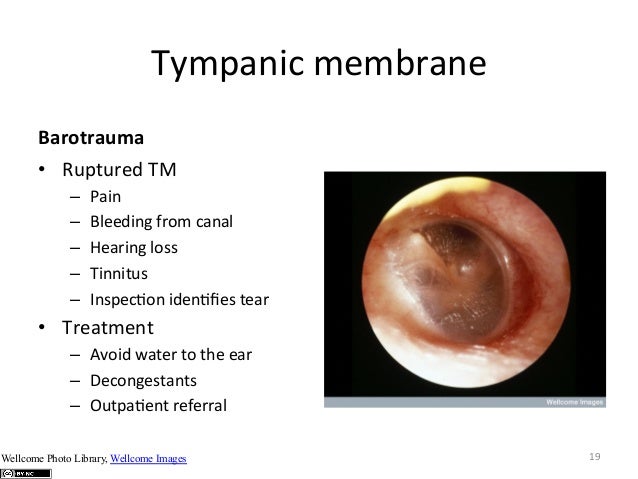
 Reverse squeeze: when inflamed or partially obstructed sinus, increased air expansion intrasinus pressure without this compensated pressure release. Normal sinus: change typically compensated by pressure equilibration between the sinus ostia and the nasal cavity (i.e. Ambient pressure decreases (decrease in gravity), results in intrasinus gaseous expansion, increased intrasinus pressure. Secondary shifts in barometric pressure due to altitude changes are the most common cause. It also generally takes longer to ascend/descend in air than water. Example: pressure change from rapid 5 m underwater dive is equivalent to a 5500 m descent above sea level. Because air is more compressible than water, it takes much greater changes in elevation to achieve the same pressure change as water depth. Difference between properties of water and air explains why it is more common in divers.
Reverse squeeze: when inflamed or partially obstructed sinus, increased air expansion intrasinus pressure without this compensated pressure release. Normal sinus: change typically compensated by pressure equilibration between the sinus ostia and the nasal cavity (i.e. Ambient pressure decreases (decrease in gravity), results in intrasinus gaseous expansion, increased intrasinus pressure. Secondary shifts in barometric pressure due to altitude changes are the most common cause. It also generally takes longer to ascend/descend in air than water. Example: pressure change from rapid 5 m underwater dive is equivalent to a 5500 m descent above sea level. Because air is more compressible than water, it takes much greater changes in elevation to achieve the same pressure change as water depth. Difference between properties of water and air explains why it is more common in divers. 
May be difficult to distinguish from other causes of sinusitis due to lack of familiarity with condition, paucity of literature.Frontal sinus most commonly affected, followed by maxillary sinus.

Obstruction of the nasal sinuses combined with the increased pressures of diving may result in sinonasal barotrauma.Describes the varying degrees of sinonasal injury and/or inflammation that result when the aerated spaces of the nose and sinuses are exposed to an uncompensated change in ambient pressure.

(C) Type 3 frontal cell that compromises sinus outflow a reverse squeeze or compression injury may occur in both the frontal sinus and obstructing type 3 cell, producing severe, but focal, symptoms. Decrease in gaseous volume within the sinuses during descent creates intrasinus decompression without inward pressure equalization this results in “pulling” forces within the sinus cavity that can cause mucosal edema, avulsion of the mucosal surface from the bone, and hematoma formation, depending on the degree and rapidity of the pressure shifts. (B) A squeeze or decompression injury in an inflamed or partially obstructed sinus. Increased air expansion and elevated intrasinus pressure during ascent, without compensated pressure release, produces an outward, “expansile” compression injury of the sinus mucosa against the bony sinus outer walls this results in mucosal edema and rupture. (A) Reverse squeeze or compression injury in an inflamed or partially obstructed sinus. Illustrations that depict scenarios of sinus barotrauma.
Prevalence of sinus barotrauma in patients who undergo hyperbaric oxygen exposure is reported to be around 3%. If concurrent sinonasal inflammation, that number increases to 55% in commercial pilots, 34% in high performance pilots. Among pilots, prevalence estimated 19.5-25%. One study estimates the prevalence at 34%. Overall, lack of good epidemiological data. First case reported in the diving literature by Flottes in 1965. Pathophysiology first described by Campbell in 1942. First described in WW2 aviation literature. This page refers to sinus barotrauma, which can occur during scuba diving or air flight due to changes in pressure within a non-draining sinus. 8.1 Proposed Classification by Vaezeafshar. 5.1 Differential Diagnosis Dive Medicine.








 0 kommentar(er)
0 kommentar(er)
